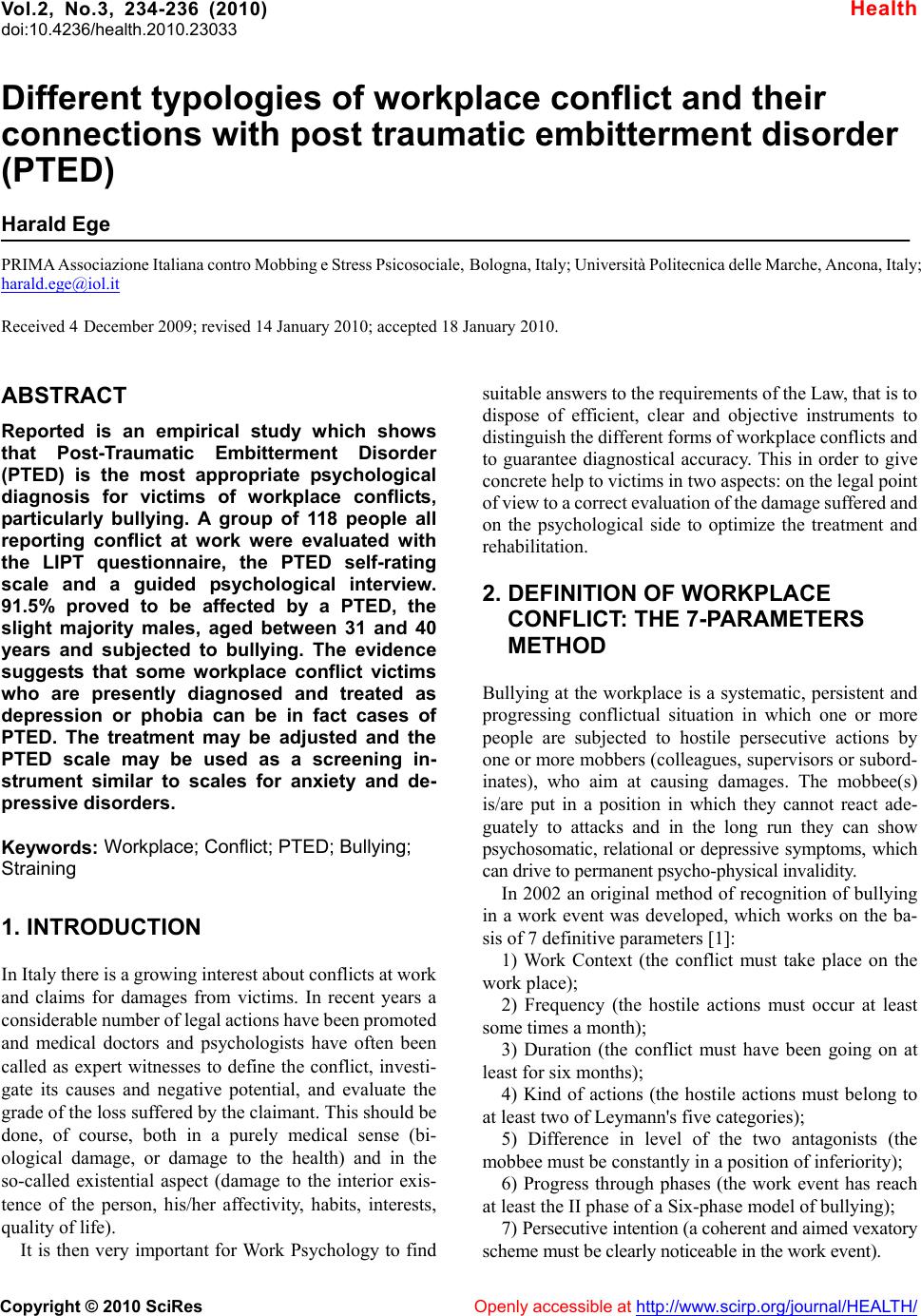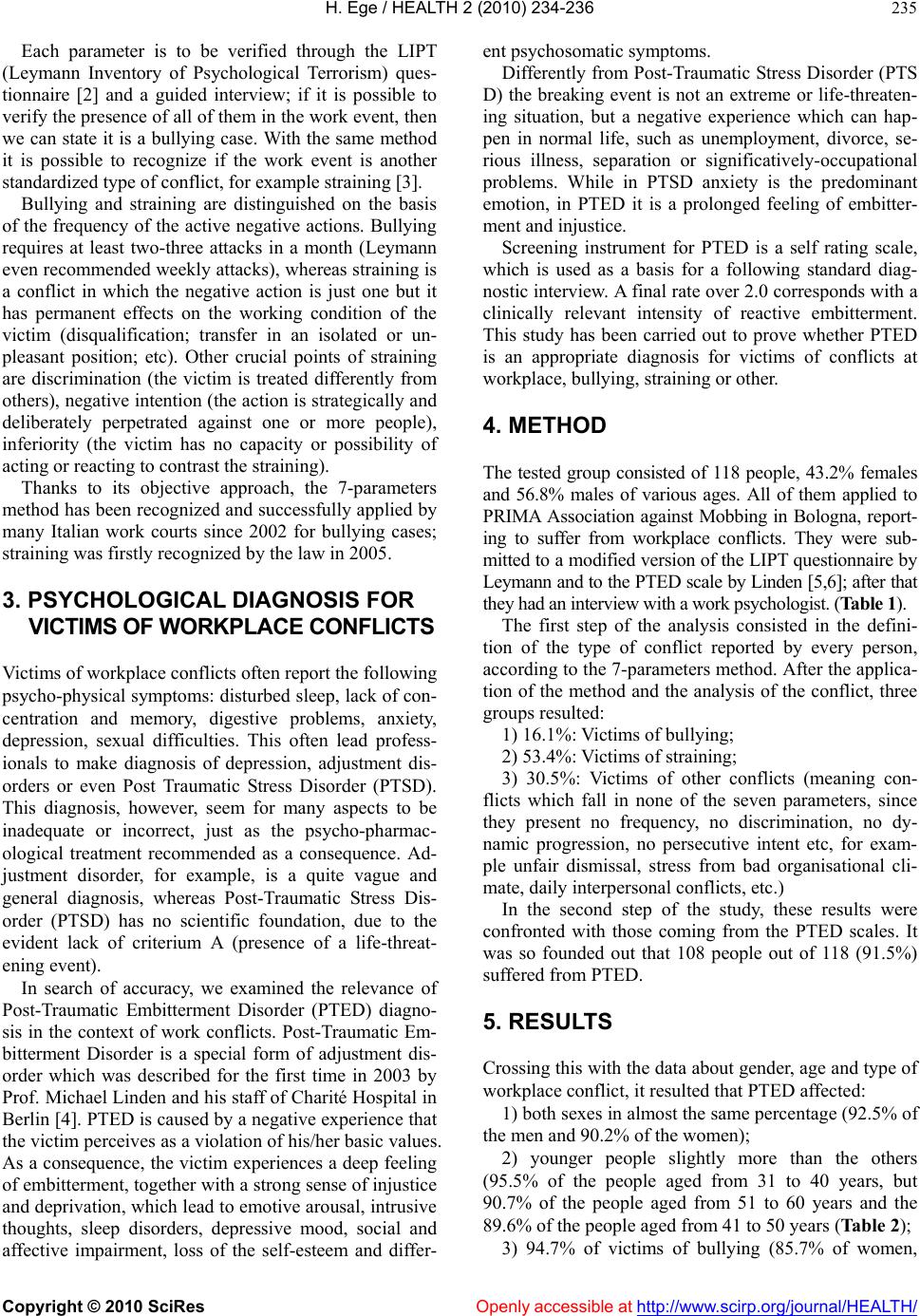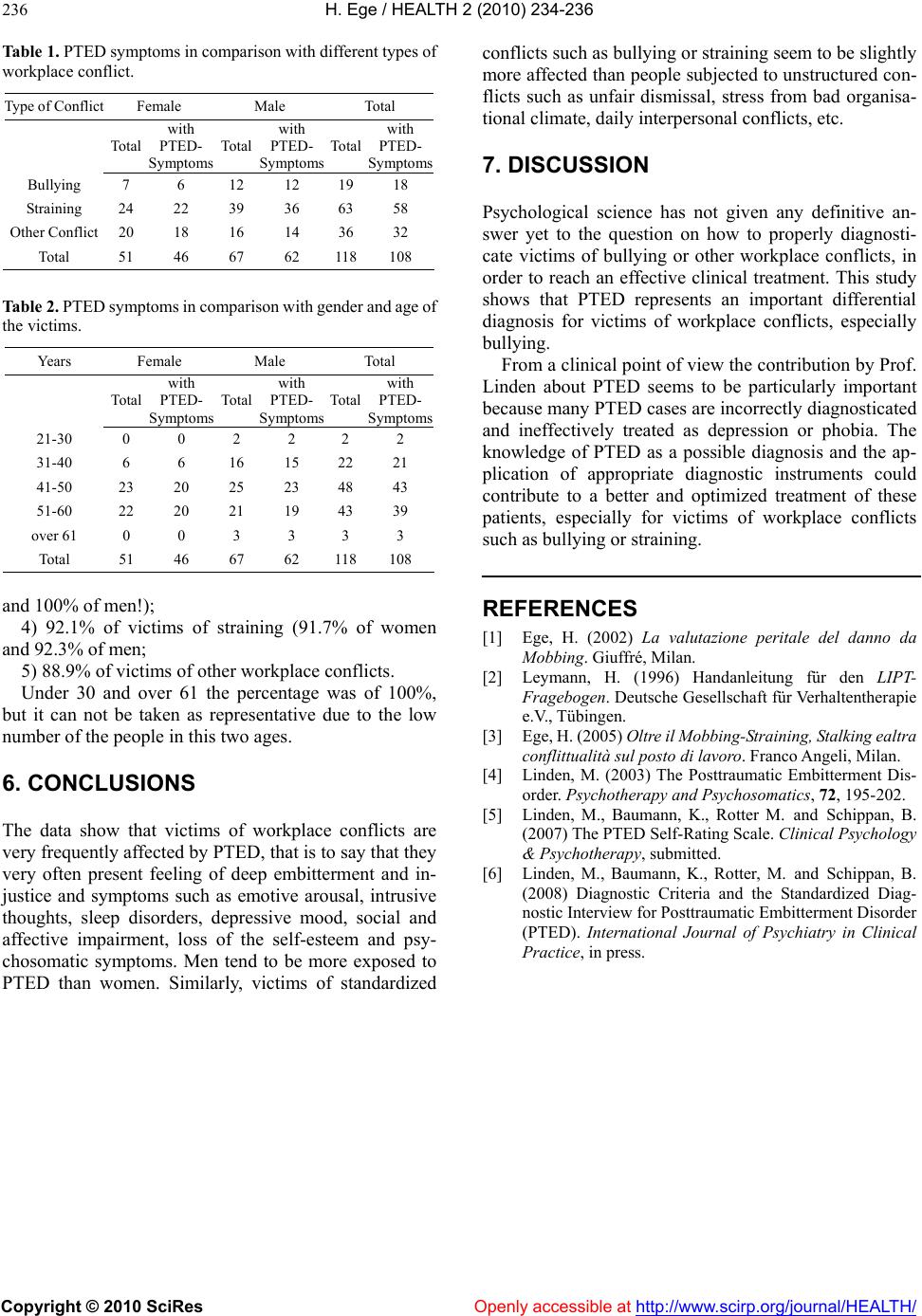Paper Menu >>
Journal Menu >>
 Vol.2, No.3, 234-236 (2010) doi:10.4236/health.2010.23033 Copyright © 2010 SciRes Openly accessible at http://www.scirp.org/journal/HEALTH/ Health Different typologies of workplace conflict and their connections with post traumatic embitterment disorder (PTED) Harald Ege PRIMA Associazione Italiana contro Mobbing e Stress Psicosociale, Bologna, Italy; Università Politecnica delle Marche, Ancona, Italy; harald.ege@iol.it Received 4 December 2009; revised 14 January 2010; accepted 18 January 2010. ABSTRACT Reported is an empirical study which shows that Post-Traumatic Embitterment Disorder (PTED) is the most appropriate psychological diagnosis for victims of workplace conflicts, particularly bullying. A group of 118 people all reporting conflict at work were evaluated with the LIPT questionnaire, the PTED self-rating scale and a guided psychological interview. 91.5% proved to be affected by a PTED, the slight majority males, aged between 31 and 40 years and subjected to bullying. The evidence suggests that some workplace conflict victims who are presently diagnosed and treated as depression or phobia can be in fact cases of PTED. The treatment may be adjusted and the PTED scale may be used as a screening in- strument similar to scales for anxiety and de- pressive disorders. Keywords: Workplace; Conflict; PTED; Bullying; Straining 1. INTRODUCTION In Italy there is a growing interest about conflicts at work and claims for damages from victims. In recent years a considerable number of legal actions have been promoted and medical doctors and psychologists have often been called as expert witnesses to define the conflict, investi- gate its causes and negative potential, and evaluate the grade of the loss suffered by the claimant. This should be done, of course, both in a purely medical sense (bi- ological damage, or damage to the health) and in the so-called existential aspect (damage to the interior exis- tence of the person, his/her affectivity, habits, interests, quality of life). It is then very important for Work Psychology to find suitable answers to the requirements of the Law, that is to dispose of efficient, clear and objective instruments to distinguish the different forms of workplace conflicts and to guarantee diagnostical accuracy. This in order to give concrete help to victims in two aspects: on the legal point of view to a correct evaluation of the damage suffered and on the psychological side to optimize the treatment and rehabilitation. 2. DEFINITION OF WORKPLACE CONFLICT: THE 7-PARAMETERS METHOD Bullying at the workplace is a systematic, persistent and progressing conflictual situation in which one or more people are subjected to hostile persecutive actions by one or more mobbers (colleagues, supervisors or subord- inates), who aim at causing damages. The mobbee(s) is/are put in a position in which they cannot react ade- guately to attacks and in the long run they can show psychosomatic, relational or depressive symptoms, which can drive to permanent psycho-physical invalidity. In 2002 an original method of recognition of bullying in a work event was developed, which works on the ba- sis of 7 definitive parameters [1]: 1) Work Context (the conflict must take place on the work place); 2) Frequency (the hostile actions must occur at least some times a month); 3) Duration (the conflict must have been going on at least for six months); 4) Kind of actions (the hostile actions must belong to at least two of Leymann's five categories); 5) Difference in level of the two antagonists (the mobbee must be constantly in a position of inferiority); 6) Progress through phases (the work event has reach at least the II phase of a Six-phase model of bullying); 7) Persecutive intention (a coherent and aimed vexatory scheme must be clearly noticeable in the work event).  H. Ege / HEALTH 2 (2010) 234-236 Copyright © 2010 SciRes Openly accessible at http://www.scirp.org/journal/HEALTH/ 235 Each parameter is to be verified through the LIPT (Leymann Inventory of Psychological Terrorism) ques- tionnaire [2] and a guided interview; if it is possible to verify the presence of all of them in the work event, then we can state it is a bullying case. With the same method it is possible to recognize if the work event is another standardized type of conflict, for example straining [3]. Bullying and straining are distinguished on the basis of the frequency of the active negative actions. Bullying requires at least two-three attacks in a month (Leymann even recommended weekly attacks), whereas straining is a conflict in which the negative action is just one but it has permanent effects on the working condition of the victim (disqualification; transfer in an isolated or un- pleasant position; etc). Other crucial points of straining are discrimination (the victim is treated differently from others), negative intention (the action is strategically and deliberately perpetrated against one or more people), inferiority (the victim has no capacity or possibility of acting or reacting to contrast the straining). Thanks to its objective approach, the 7-parameters method has been recognized and successfully applied by many Italian work courts since 2002 for bullying cases; straining was firstly recognized by the law in 2005. 3. PSYCHOLOGICAL DIAGNOSIS FOR VICTIMS OF WORKPLACE CONFLICTS Victims of workplace conflicts often report the following psycho-physical symptoms: disturbed sleep, lack of con- centration and memory, digestive problems, anxiety, depression, sexual difficulties. This often lead profess- ionals to make diagnosis of depression, adjustment dis- orders or even Post Traumatic Stress Disorder (PTSD). This diagnosis, however, seem for many aspects to be inadequate or incorrect, just as the psycho-pharmac- ological treatment recommended as a consequence. Ad- justment disorder, for example, is a quite vague and general diagnosis, whereas Post-Traumatic Stress Dis- order (PTSD) has no scientific foundation, due to the evident lack of criterium A (presence of a life-threat- ening event). In search of accuracy, we examined the relevance of Post-Traumatic Embitterment Disorder (PTED) diagno- sis in the context of work conflicts. Post-Traumatic Em- bitterment Disorder is a special form of adjustment dis- order which was described for the first time in 2003 by Prof. Michael Linden and his staff of Charité Hospital in Berlin [4]. PTED is caused by a negative experience that the victim perceives as a violation of his/her basic values. As a consequence, the victim experiences a deep feeling of embitterment, together with a strong sense of injustice and deprivation, which lead to emotive arousal, intrusive thoughts, sleep disorders, depressive mood, social and affective impairment, loss of the self-esteem and differ- ent psychosomatic symptoms. Differently from Post-Traumatic Stress Disorder (PTS D) the breaking event is not an extreme or life-threaten- ing situation, but a negative experience which can hap- pen in normal life, such as unemployment, divorce, se- rious illness, separation or significatively-occupational problems. While in PTSD anxiety is the predominant emotion, in PTED it is a prolonged feeling of embitter- ment and injustice. Screening instrument for PTED is a self rating scale, which is used as a basis for a following standard diag- nostic interview. A final rate over 2.0 corresponds with a clinically relevant intensity of reactive embitterment. This study has been carried out to prove whether PTED is an appropriate diagnosis for victims of conflicts at workplace, bullying, straining or other. 4. METHOD The tested group consisted of 118 people, 43.2% females and 56.8% males of various ages. All of them applied to PRIMA Association against Mobbing in Bologna, report- ing to suffer from workplace conflicts. They were sub- mitted to a modified version of the LIPT questionnaire by Leymann and to the PTED scale by Linden [5,6]; after that they had an interview with a work psychologist. (Table 1). The first step of the analysis consisted in the defini- tion of the type of conflict reported by every person, according to the 7-parameters method. After the applica- tion of the method and the analysis of the conflict, three groups resulted: 1) 16.1%: Victims of bullying; 2) 53.4%: Victims of straining; 3) 30.5%: Victims of other conflicts (meaning con- flicts which fall in none of the seven parameters, since they present no frequency, no discrimination, no dy- namic progression, no persecutive intent etc, for exam- ple unfair dismissal, stress from bad organisational cli- mate, daily interpersonal conflicts, etc.) In the second step of the study, these results were confronted with those coming from the PTED scales. It was so founded out that 108 people out of 118 (91.5%) suffered from PTED. 5. RESULTS Crossing this with the data about gender, age and type of workplace conflict, it resulted that PTED affected: 1) both sexes in almost the same percentage (92.5% of the men and 90.2% of the women); 2) younger people slightly more than the others (95.5% of the people aged from 31 to 40 years, but 90.7% of the people aged from 51 to 60 years and the 89.6% of the people aged from 41 to 50 years (Table 2); 3) 94.7% of victims of bullying (85.7% of women,  H. Ege / HEALTH 2 (2010) 234-236 Copyright © 2010 SciRes http://www.scirp.org/journal/HEALTH/ 236 Table 1. PTED symptoms in comparison with different types of workplace conflict. Type of Conflic t Female Male Total Total with PTED- Symptoms Total with PTED- Symptoms Total with PTED- Symptoms Bullying 7 6 1212 19 18 Straining 24 22 3936 63 58 Other Conflict 20 18 1614 36 32 Total 51 46 6762 118 108 Openly accessible at Table 2. PTED symptoms in comparison with gender and age of the victims. Years Female Male Total Total with PTED- Symptoms Total with PTED- Symptoms Total with PTED- Symptoms 21-30 0 0 2 2 2 2 31-40 6 6 1615 22 21 41-50 23 20 2523 48 43 51-60 22 20 2119 43 39 over 61 0 0 3 3 3 3 Total 51 46 6762 118 108 and 100% of men!); 4) 92.1% of victims of straining (91.7% of women and 92.3% of men; 5) 88.9% of victims of other workplace conflicts. Under 30 and over 61 the percentage was of 100%, but it can not be taken as representative due to the low number of the people in this two ages. 6. CONCLUSIONS The data show that victims of workplace conflicts are very frequently affected by PTED, that is to say that they very often present feeling of deep embitterment and in- justice and symptoms such as emotive arousal, intrusive thoughts, sleep disorders, depressive mood, social and affective impairment, loss of the self-esteem and psy- chosomatic symptoms. Men tend to be more exposed to PTED than women. Similarly, victims of standardized conflicts such as bullying or straining seem to be slightly more affected than people subjected to unstructured con- flicts such as unfair dismissal, stress from bad organisa- tional climate, daily interpersonal conflicts, etc. 7. DISCUSSION Psychological science has not given any definitive an- swer yet to the question on how to properly diagnosti- cate victims of bullying or other workplace conflicts, in order to reach an effective clinical treatment. This study shows that PTED represents an important differential diagnosis for victims of workplace conflicts, especially bullying. From a clinical point of view the contribution by Prof. Linden about PTED seems to be particularly important because many PTED cases are incorrectly diagnosticated and ineffectively treated as depression or phobia. The knowledge of PTED as a possible diagnosis and the ap- plication of appropriate diagnostic instruments could contribute to a better and optimized treatment of these patients, especially for victims of workplace conflicts such as bullying or straining. REFERENCES [1] Ege, H. (2002) La valutazione peritale del danno da Mobbing. Giuffré, Milan. [2] Leymann, H. (1996) Handanleitung für den LIPT- Fragebogen. Deutsche Gesellschaft für Verhaltentherapie e.V., Tübingen. [3] Ege, H. (2005) Oltre il Mobbing-Straining, Stalking ealtra conflittualità sul posto di lavoro. Franco Angeli, Milan. [4] Linden, M. (2003) The Posttraumatic Embitterment Dis- order. Psychotherapy and Psychosomatics, 72, 195-202. [5] Linden, M., Baumann, K., Rotter M. and Schippan, B. (2007) The PTED Self-Rating Scale. Clinical Psychology & Psychotherapy, submitted. [6] Linden, M., Baumann, K., Rotter, M. and Schippan, B. (2008) Diagnostic Criteria and the Standardized Diag- nostic Interview for Posttraumatic Embitterment Disorder (PTED). International Journal of Psychiatry in Clinical Practice, in press. |

